The first jet fighters A.S. Yakovlev. Part I
The Yak-15 aircraft had every chance of becoming the first Soviet jet fighter to fly into the air. However, due to caution A.S. Yakovlev, who delayed the preparation for the first flight, the Yak-15 only a couple of hours behind the MiG-9. But this does not in the least detract from his significant contribution to the development of domestic reactive aviation. This fighter and its further development of the Yak-17 will be discussed in this article.
By the end of World War II, Soviet aircraft manufacturing, due to a number of circumstances, had lagged behind the level of Germany and our allies, the United States and Great Britain, in the development and implementation of turbojet engines. By this time, the British already had Gloucester Meteor and De Havilland Vampire, the Americans had the unsuccessful P-59 Erkomet, who was replaced by Lockheed P-80 Shuting Star. In the Soviet Union, on the 9 of May 1945, there was practically nothing, and it was urgent to overcome this lag.
Great help in this was the study of captured German samples of jet technology captured at the end of the war. Among them were jet engines YuMO 004 and BMW 003, which were in the hands of Soviet specialists in quite a significant number. It was decided to copy these engines and launch them into mass production in our country (under the names RD-10 and RD-20, respectively), and also to start developing several types of fighters and bombers for these engines. Among the design bureaus that received the corresponding tasks, there was A.D.-115 OKB. Yakovlev.
In early April, the GKO issued a decree that instructed the OKB-1945 to construct, construct and submit for testing a single-seat fighter with a turbojet (TRD) YuMO 115. To save time and quickly complete this task, Yakovlev decided to use the well-tested and tested Yak-004 piston as a basis for the new aircraft.
The first prototype of the fighter, later known as the Yak-15, originally wore the designation Yak-YuMO (Yak-3 YuMO). It was essentially a repetition, with minor changes, of the design of the all-metal version of the Yak-3 with a VK-107A piston motor, in place of which the German trophy YUMO 004B was put in with the 900 kgf. By the way, there are not so many examples of direct reworking a piston fighter into a jet. At Focke-Wulf, in 1942, an experiment was conducted as an experiment to adapt the FW-190 fighter to a turbojet engine (Yakovlev, apparently, did not know about this during the work on the Yak-YuMO). At one of the creators of the aircraft LaGG, M.I. Gudkov, the project of reworking LaGG-1942 for the RD-3 AM engine was worked out in 1. Cradles under the redannaya scheme, similar to the one that later successfully used Yakovlev. The Swedes built and successfully tested a SAAB J-21R fighter jet on the basis of the two-beam SAAB J-21, on which, instead of a DB 605 piston motor with a pushing screw, they mounted an English TRD of the Goblin type.
The fuselage of the Yak-YuMO was generally similar to the design of the Yak-3 (a truss from steel pipes with duralumin cladding), but it had to be significantly modified for a new powerplant. A jet engine with a frontal air intake was installed from the bottom in front of the fuselage with the engine tilted at 4 °, with a nozzle exit from the bottom of the middle part of the fuselage (the so-called redannaya scheme). As a result, the nose of the aircraft acquired a characteristic "hanging down" profile, which improved the visibility for the pilot and made it possible to have a fairly good overview ahead also on the taxiing. The redrawn scheme avoided the long inlet duct and the long nozzle pipe, and thus the losses in the engine, which is not very powerful. The tail section behind the engine nozzle was cut from below and covered with a heat shield steel screen. The wing, landing gear and tail unit were preserved in almost unchanged form. It was necessary only to give the forward spar curved upwards in the place of its passage above the engine and remove the oil radiators from the leading edge, as well as slightly increase the area of the vertical tail. At the same time, the wing was slightly raised and with the new form of the nose of the fuselage became almost midway. The wing housed four main fuel tanks. The fifth (reserve) was located above the engine. It must be said that the thick profile of the wing, taken unchanged from the Yak-3, limited the speed capabilities of the aircraft. The maximum speed was also limited for reasons of strength.
In the nose of the aircraft above the engine was designed to install weapons, consisting of two guns NS-23K, although the prototype guns were not. The first experienced Yak-YUMO, obtained by reworking the serial Yak-3, was completed in October 1945. The first races of the engine on the plane showed that the designers had made some miscalculations. The temperature of the gas jet was significantly higher than expected. The steel screen of the lower part of the fuselage was made too short, and the duralumin sheeting behind it immediately burnt out. Rubber wheel flared. I had to send the plane to the pilot production for repairs and modifications. The bottom skin was made double, with an outer screen made of heat-resistant steel, providing thermal insulation by blowing air between the screen and the fuselage. Tail wheel with pneumatics, replaced by a metal with a sprung rim. These works were completed at the end of December 1945.
By this time, they managed to finish the second experienced Yak-YuMO. He mounted a stabilizer of increased scope and area, and heat-resistant steel tail wheel. The second prototype had standard armament of two X-NUMX-mm guns НС-23. The guns on the Yak-YuMO (as well as on the serial Yak-23) were installed so that their trunks did not protrude beyond the edge of the engine air intake; thanks to this, the firing of guns did not adversely affect the stable operation of the engine. This decision turned out to be the right one, since the MiG-15 fighter, with its highly protruding cannons, brought designers many problems with the surge of the propulsion system during firing.
Shortly after the first flights, this copy was transferred to TsAGI for full-scale blowing of an airplane with a running engine in a T-101 wind tunnel. These blowdowns with various combinations of airspeed and angle of attack provided valuable data regarding the pitch balancing of the aircraft, given that the thrust line was below the center of gravity.
In mid-February 1946, the second prototype was returned to LII, where the runs were resumed. And on April 24, 1946, the first flight of the new fighter took place.
Factory tests of a jet engine, which was held in different documents already under the names Yak-15, Yak-15-RD-10 and Yak-RD, ended on 22 June 1946. During the tests, 19 flights of the total duration of 6 hour were completed. 34 min. In the course of these tests, the aircraft, which had a take-off weight of 2570 kg, managed to reach a maximum speed at the ground of 770 km / h and 800 km / h at altitude. The practical range of flight was equal to 575 km. These indicators were at the level specified in the order of the MAP from 27 March 1946 g, with the exception of speed at height - the plane didn’t get 50 km / h to the required 850 km / h. The plane had a run-up 520 m, mileage 480 m, landing speed 148 km / h , and its technical flight duration at a speed of 500 km / h was 45 min.
The longitudinal, transverse and ground stability of the aircraft was rated as good, the landing was “simple and similar to the Yak-3”. Test-pilots who flew around the plane unanimously gave a high rating to its aerobatic qualities. Gm Shiyanov pointed out: “It is very pleasant to behave at high speeds. Aircraft control is soft and not tiring. " The pilots noted that the aircraft "can easily be mastered by the flight crew of the medium-skilled air force."
It is curious that the designation Yak15-РД-10 appeared even before the engine РД-10 was actually put on the plane. 29 of April, by a government decree and the relevant order of the IAP OKB-115, was commissioned to release two prototypes of the new fighter already with the TRD RD-10 - the Soviet version of the YuMO 004В engine. The first one was to be submitted for testing in the third quarter of 1946. In fact, the designers had only to replace the YuMO 004В engines with the RD-10 on the already built two experimental machines.
In August 1946, the Yak-15, together with the I-300 (MiG-9) took part in the Tushino air parade. Shortly thereafter, Yakovlev and Mikoyan received a personal assignment from I.V. Stalin on the construction of 15 copies of each type for the November parade. “Front” Yak-15 (Yak15-RD10) were to be performed without armament and body armor, with an increased increased fuselage tank (due to the volume occupied on combat vehicles with automatic ammunition cannons) and reduced set of radio equipment. Production of the Yak-15 was assigned to the aircraft plant number 31 in Tbilisi, which was able to produce a small series in time. However, that year the parade over Red Square was canceled due to bad weather conditions.
The first Yak-15, made in Tbilisi at plant No. 31 and the last car of the small series in December 1946, were presented to the State Research Institute of the Air Force for state tests, which were successful in April 1947. These machines were equipped with one HC-23 gun, and their take-off weight was 2742 kg. The gun was located on the right in the nose of the fuselage. The remaining vehicles of the experimental series did not have weapons at all and had a full-sized tank in the bow (which was reduced in size with weapons). These aircraft initially had a single-beam antenna without a rack; later, on the recommendation of the Air Force Institute on two airplanes that underwent state tests, a dual-beam antenna was installed with a stand to the right of the lantern (which was later introduced into the series). On aircraft No.31015, the RPKO-10М radio-compass with an external loop antenna was supplied.
On the 9-th serial copy, tests were carried out to determine the piloting characteristics. 25 February 1947, test pilot PM Stefanovsky performed a series of aerobatics on this plane. In early May 1947, an act of state trials was approved. It reflects the many identified shortcomings of the aircraft. However, in conclusion, it was noted: “The Yak-15 jet fighters in the training version No. 31015, 31002 and 31009 state tests were satisfactory ... The Yak-15 aircraft meets the requirements of the Air Force for a training jet fighter ... Owing to extremely small the flight range (300 km) to bring the aircraft to a combat state is inexpedient, since in this case its flight qualities deteriorate due to a significant increase in flight weight due to fuel to achieve a flight range that 800-900 km. Consider it necessary, due to the simplicity of the design, low thrust of the RD-10 engine and ease of piloting, to modify the Yak-15 in the training with dual control and three-wheeled chassis ... "
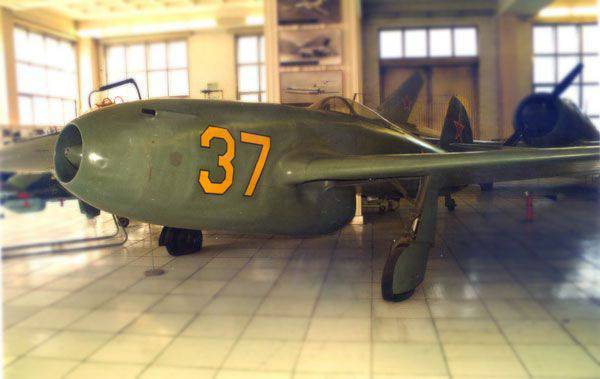
As can be seen from the above conclusion, the single Yak-15 was considered as a training fighter, and not as a combat one. As always, the overall positive opinion was accompanied by a list of defects to be fixed and the desired improvements. In particular, it was proposed to eliminate the longitudinal instability of the aircraft (in state tests, in contrast to the factory tests, the Yak-15’s longitudinal stability was more critically evaluated). It was recommended to install a two-beam mast antenna; Strengthen the cannon farm, ensuring its survivability up to 4000 shots; equip cabin with heating system; install a camera-type gun shooter on the type of the Yak-11 aircraft, and much more.
In the middle of December 1946, when state tests were still underway, the USSR Council of Ministers issued a decree, followed by the corresponding order of the Anti-Monopoly Ministry, in which the Tbilisi Aviation Plant was instructed to release 1947 YN-50 fighters with TRD RD-15 in January-March; Of these, 10 should have been single, and the rest should be released in a double training modification. Unlike the first series in 25 machines, these aircraft were supposed to carry weapons, however, the Deputy Minister of Aviation Industry P. Dementiev, in January 15, argued that these aircraft were built without weapons, because at that time the NS- 1947K did not pass state tests and were not mass-produced. Only upon completion of this series in 23 machines (50 together with the initial series) could, according to Dementiev, proceed to the release of these fighters with armament, armor and radio subwoofer RPKO-65М with the antenna hidden in the fuselage (it was originally mounted outside). It is not known to what extent this recommendation of Dementiev was implemented, but it is clear that a significant part of the production machines did not have weapons or had only one gun. Later serial cars were produced with two automatic guns НС-10 and with a stand of a two-beam antenna on the right side of the cabin canopy.
As E. Adler (at that time, the lead designer for the Yak-15 who was responsible for the release of the "front party" Yak-15 in Tbilisi) said in his memoirs, on his initiative, in parallel with this work, the "above-plan" copy of the Yak -15 with a pair of 30-mm experienced guns, which were obtained by Yakovlev from Spit. The aircraft was shot in the factory dash and sent to Moscow with the main batch of aircraft, but this option was not developed further.
1 of May 1947 of the year during the parade over Red Square links passed 50 Jacob and the same MiG-9. In the same year in Tushino for the first time demonstrated aerobatics on jet machines. First, the complex of aerobatic maneuvers was performed by Colonel I. Polunin, followed by his skill demonstrated by the link of Colonel N. Khramov. In 1948, the flight five was created on the Yak-15, which was headed twice by the Hero of the Soviet Union, General E.Ya. Savitsky, in 1949, another five of Colonel P. Chupikov was added to it.
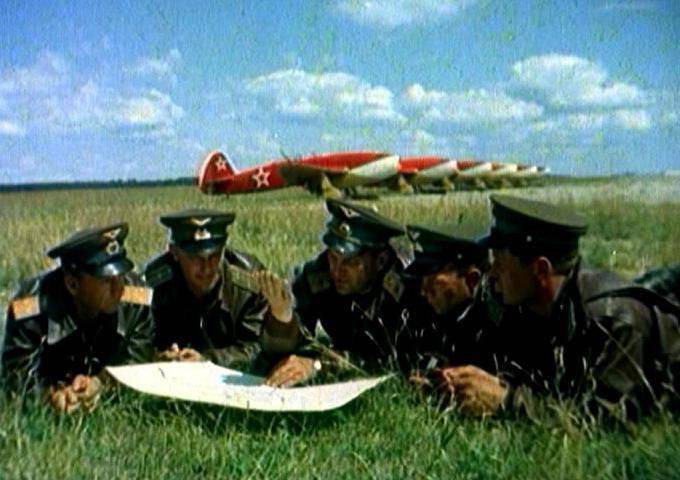
The Yak-15 was built serially from 1946 to 1947. At the Tbilisi Aviation Plant, 280 machines were produced. Most of them remained in service for several more years. During operation, various defects were detected. So, for example, there were cases of stopping RD-10 engines at high altitudes. The reason was the power failure of the fuel engines due to the formation of air plugs in the booster computations of the fuel tanks. To eliminate this phenomenon, it was decided to drain the boosterpacks, as well as install fuel tanks on the Yak-15, adapted for negative overloads. It should be said here that the RD-10 engines, despite such a disadvantage as a small resource, have generally proved themselves to be reliable enough and consistently working on the Yak-15 and further versions of this aircraft - of course, provided that the new technique.
As they were decommissioned, some copies were transferred to aviation schools. Thus, in the 1954, at the Leningrad Institute of Aviation Instrumentation, it was possible to see the Yak-15, which, along with several MiG-9, was used as a teaching aid (field stand).
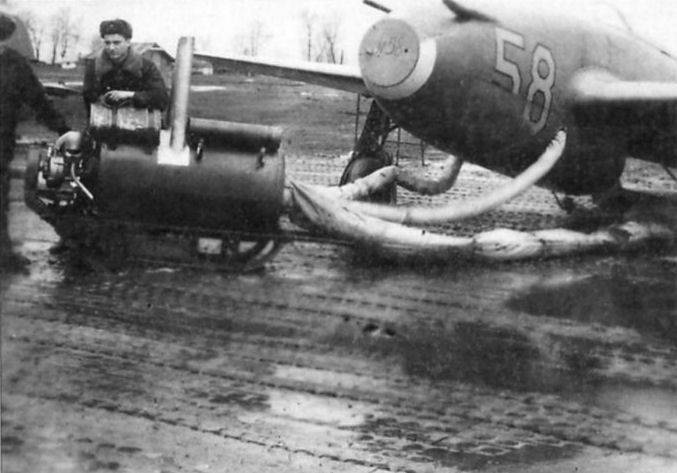
On the basis of the Yak-15 aircraft were released experimental options, remaining in single samples. One of them was the Yak-17 RD-10 (Yak-RD, Yak-RDYu) (the first with the designation Yak-17), completed by construction in the first days of September 1946. It was distinguished from its predecessor by a new wing composed of high-speed laminated TsAGI profiles, a modified tail unit, an ejection pilot seat with an armored seat, the installation of a front armored glass 55 mm thick. The chassis has also changed, since the old one could not be placed in a new thin wing. In the new version, the main supports were mounted on the power elements of the fuselage, and the cleaning was carried out back into the fuselage niches with the wheel turned to 180 ° around the rack. The plane passed ground tests, there were taxiing, but did not lift the plane into the air. At this time, the Yak-15 was produced in series, and its further development saw a machine having a more promising chassis with a nose strut.
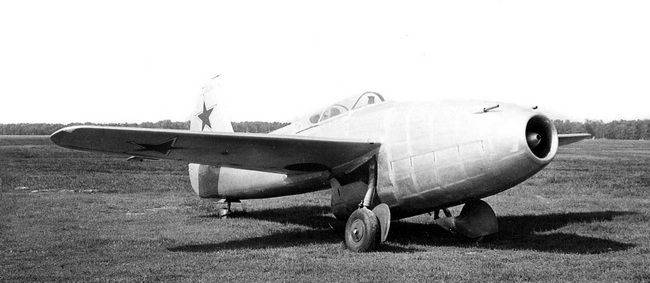
The serial Yak-15 (board "47") was used by LII at the end of the forties. As a flying laboratory to work out the wing refueling system in the air. In 1948, a group of designers LII, headed by V.S. Vakhmistrovym (known from his experience with the “Link” aircraft), developed a refueling system in which the tanker aircraft and the aircraft being filled produced cables and obtained their coupling with each other due to the special maneuvering of the tanker. After that, from the wing or fuselage of the tanker, a filling hose was produced, which was tightened by a cable to the end of the wing of the aircraft being filled and was locked there. Then began the process of transfer of fuel under the action of gravity. Soon, the test pilots LII I. Shelest and V. Vasyanin developed a more rational system of refueling “from wing to wing,” in which the planes went on parallel courses and the refueling plane did not need to enter the tanker wake. The system was successfully tested on two modified Tu-2 airplanes, and then the mentioned Yak-15 47 board was also equipped with a dummy receiver on the wing console and simulated refueling in flight from the Tu-2.
In parallel with the creation of the basic single combat version of the Yak-15, it was planned to develop its double training (export) version. Initially, it was designated Yak-YUMO "export", later Yak-15В, Yak-15УТ, but in the end he was given the official designation Yak-21. On the export version there was no armament, and on the place of the fuselage fuel tank mounted cabin for the cadet. Both cabins are a common drop-shaped lantern with two sliding parts without a gap between them. An experienced “Sparka” was also produced in Tbilisi. The plane was laid back in 1946, but the first flight of the Yak-21 took place on 5 on April 1947. The planned release of another 25 aircraft of this modification did not take place, since by that time another version of the Sparky had been developed - the Yak-21T with the nose-post, which became the Yak-17UTI series.
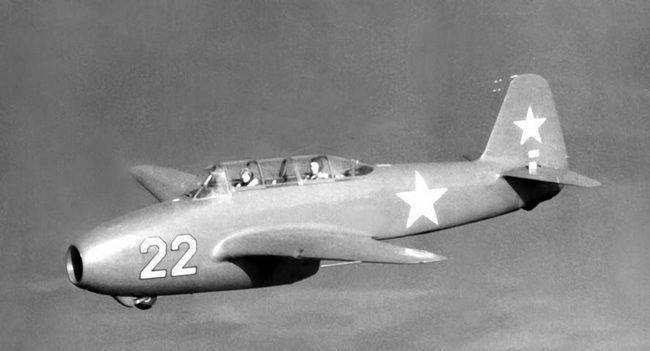
To be continued ...
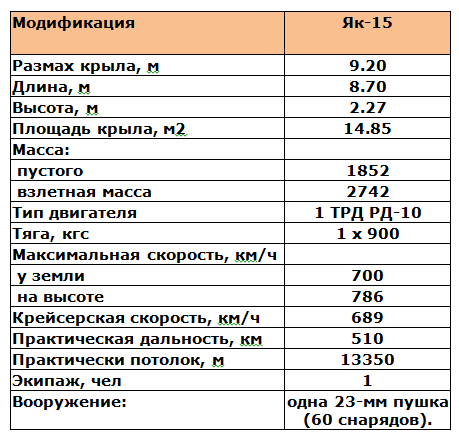
Sources:
N. Yakubovich. USSR Reactive Firstborn - MiG-9, Yak-15, Su-9, La-150, Tu-12, Il-22, etc. M .: Yauza, 2015. C. 25-43.
Gordon E. Reactive First-born Yakovlev // Aviation and Time. 2002. No.6. C. 5-17.
Shvydkin A. Yak-15: jet “hawk” // Aviapanorama. 2004. No.5. C. 12-16.
Komissarov S. Jet fighters of the Yak-15 / 17 family // Wings of the Motherland. 2007. No.7. C. 27-31.
Yakubovich N. Reactive "pen". Yak-17 // Wings of the Motherland. 1999. No.12. C. 1-3.
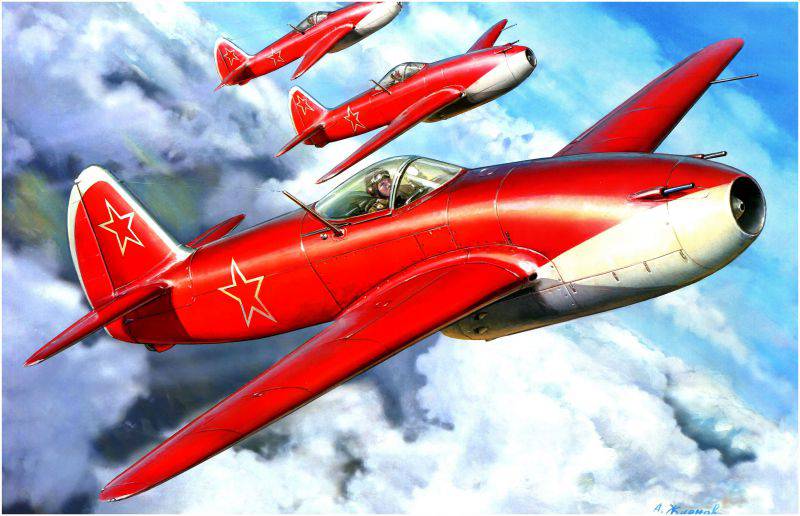
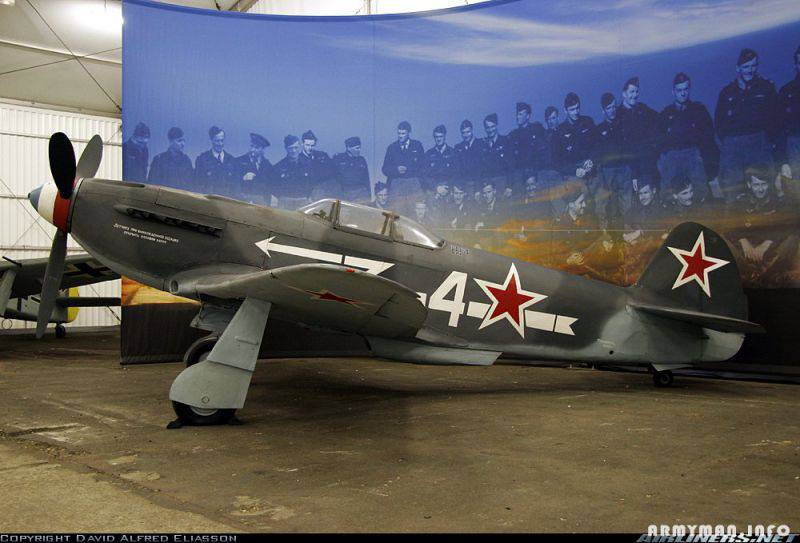
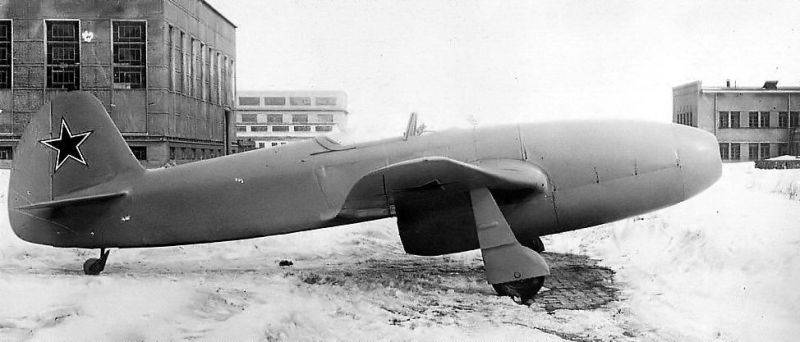
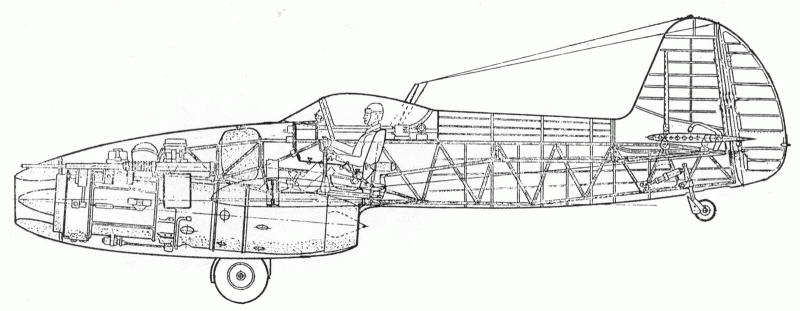
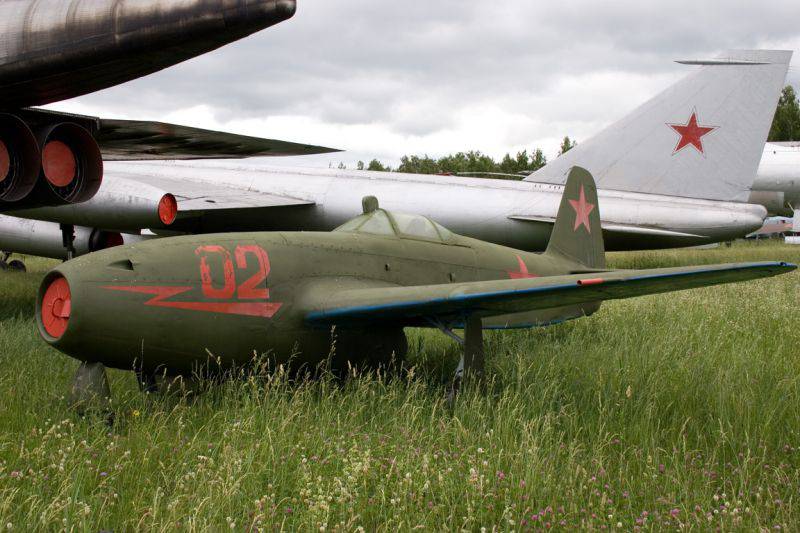
Information